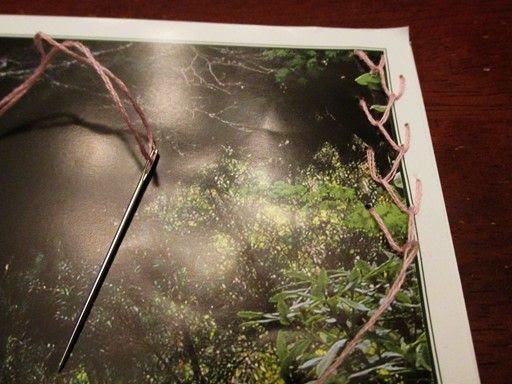My second project for Recycled Journal Week came out so well I surprised myself, and it all started with this unused 2014 calendar:

This is a big glossy wall calendar with beautiful photos of gardens around the world on lovely thick paper, and I originally planned to take it apart and use the photos to make some journal pages, which I then never got around to doing. Here's how each page in the calendar looked:

I took out the two staples holding all the pages together and cut each one in half to separate the pictures:

It took a while to figure out how to use the pictures. I knew I didn't want to use the monthly grids, and I thought of all the craft blogs I've seen use old calendars to make pretty envelopes. That sparked the light bulb for me, and I folded each picture over in half, then in half again so that the grid was on the inside, and the photo faced out:

This produced twelve rather gorgeous signatures:

Once I had them folded I could see how to make each signature into two pockets. First I stitched each open end of the signatures with some embroidery floss:


Once I had all the signatures stitched up, I used the sewing machine to stitch them to a long piece of the calendar's cardboard cover, which I cut and folded into a cover for my pockets. Sewing down the fold of each signature created two pockets (and if you try this, remember to keep the open/unstitched end up as you sew each signature to the cover):

Once all the signatures were stitched to the cover, I had a completed journal. It came out so nice I used last year's Victorian calendar to make another one, and this time I used the sewing machine for all the stitching:

Here's the inside of the garden calendar pocket journal:

And the inside of the one I made from the Victorian calendar:

What can you do with a pocket journal? Save the little stuff! I'm going to use one of mine for some ribbon and Venise lace I frequently use, but you can also pocket your mementos, receipts, notes, photos, postcards, cookie fortunes, letters, or index cards in this type of journal. As a gift for a writer pal you could make one and stuff the pockets with writing prompts, or recipes for a friend who likes your cooking:

What I learned from this project is to keep in mind what purpose you want your recycled journal to serve, and take your time figuring out how to use your materials in interesting ways. Total project time: 2 nights @ 4 hours for the garden journal, and 1 night @ 4 hours for the Victorian journal.
